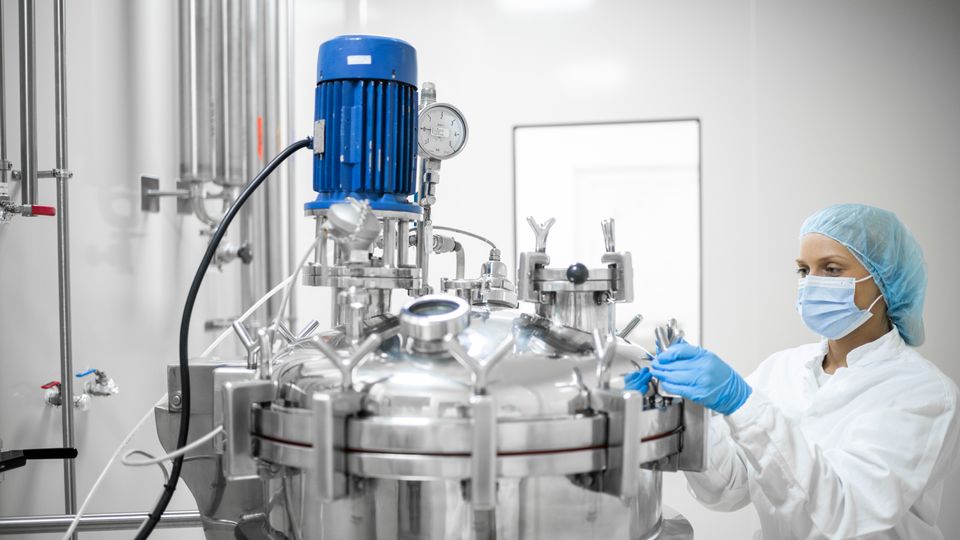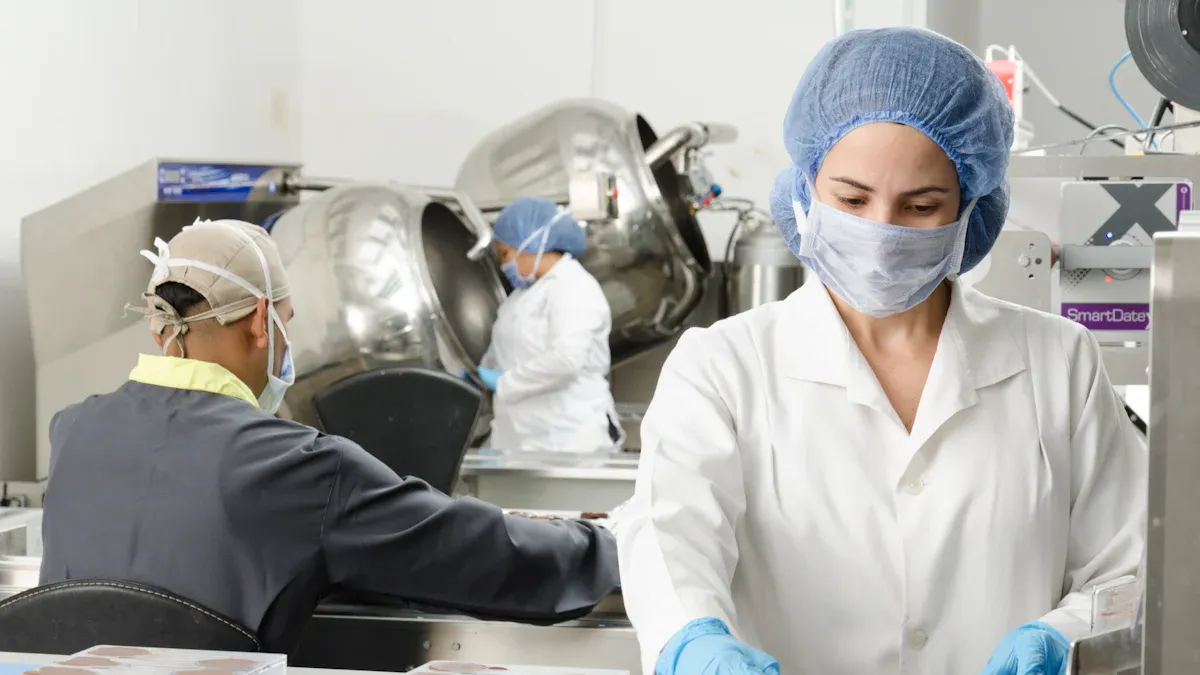

You use a Bioprocess Reactor to keep things steady in bio-manufacturing. This system lets you manage fermentation technology. You can make products better and spend less money making them. You get better results in medicine, food, nutraceuticals, and taking care of the environment. This is because it is easier and more exact to control the process.
A Bioprocess Reactor helps you work faster and follow industry rules.
Bioprocess Reactor Types

You have many Bioprocess Reactor designs to pick from. Each one is good for certain jobs. You get better results if you choose the right reactor for your needs.
Stirred-Tank
Stirred-tank reactors are common in bio-manufacturing. They use machines to mix everything inside. This helps spread nutrients and heat evenly. These reactors help control fermentation technology. They also make it easier to make more products. You can use them to make medicines, enzymes, and food ingredients.
Tip: You can change the speed and mixing in stirred-tank reactors for different products.
Airlift
Airlift reactors are good for gentle mixing. Air bubbles move the liquid around. This keeps cells healthy. They use less energy and do not hurt sensitive cells. Airlift reactors are great for growing cells and making proteins.
Packed-Bed
Packed-bed reactors are best for using immobilized cells or enzymes. They hold solid stuff in one place. Liquid moves through the bed to start reactions. These reactors help make chemicals and clean wastewater. They work well and make it easy to separate products.
Fluidized-Bed
Fluidized-bed reactors keep solid particles moving all the time. Air or liquid lifts the particles and mixes them with nutrients. This helps cells and nutrients touch each other more. These reactors help control the process and are good for making biofuel.
Single-Use
Single-use reactors are good for fast setup and flexibility. They use bags or containers you throw away after use. You do not need to clean them. This lowers the chance of contamination. Single-use reactors save time and money. They are great for small batches or new products.
Note: Single-use reactors are used a lot in modern pharmaceutical production.
Operation Modes
You can choose from several operation modes when you use a Bioprocess Reactor. Each mode helps you meet different goals in bio-manufacturing. You can improve process control and get better results by picking the right mode.
Batch
Batch mode lets you add all ingredients at the start. You run the process until it finishes. You get a set amount of product each time. This mode works well for small batches and testing new ideas. You can control the process and make changes between runs. You often use batch mode in fermentation technology for making medicines and food ingredients.
Tip: Batch mode gives you simple setup and easy cleaning.
Fed-Batch
Fed-batch mode helps you add ingredients during the process. You start with some materials, then feed more as needed. You can keep cells healthy and boost production. This mode helps you avoid problems like nutrient shortage or waste buildup. You use fed-batch mode to make proteins, enzymes, and vaccines. You get higher yields and better quality.
- You can adjust feeding rates to match cell growth.
- You can control the timing for best results.
Continuous
Continuous mode keeps the process running all the time. You add fresh materials and remove products without stopping. You get steady production and save time. This mode works best for large-scale bio-manufacturing. You can use continuous mode for making biofuels and chemicals. You get high efficiency and lower costs.
Note: Continuous mode needs strong process control to keep everything stable.
Perfusion
Perfusion mode lets you remove waste and add nutrients while keeping cells inside. You can grow cells for a long time and get more product. This mode helps you make sensitive products like antibodies and cell therapies. You get clean products and steady output.
You can pick the operation mode that fits your needs. Each mode helps you optimize production and improve efficiency in your Bioprocess Reactor.
Bioprocess Reactor Technologies
Modern technology helps you get better results. You can use new tools to make work easier and faster. These technologies help you control the process. They let you watch for changes and make more products in bio-manufacturing.
Single-Use Systems
Single-use systems help you set up fast. You can switch between products with less work. You use bags or containers that you throw away after each run. This means you spend less time cleaning. It also lowers the risk of contamination. You save money and keep your workspace safe. Many companies use single-use systems for small batches and new medicines.
Tip: You can try new ideas faster with single-use systems. You do not need to clean equipment between runs.
Sensor Integration
Sensors help you see what happens inside your reactor. You can measure temperature, pH, oxygen, and other things. This helps you keep the process steady. You can spot problems early. You use sensors to track fermentation technology. They help you make sure your products meet quality standards.
- You can set alarms to warn you if something is wrong.
- You can collect data to help future runs.
Scale-Up
You start with small tests. You need to make more product as demand grows. Scale-up means you move from small reactors to bigger ones. You use special designs to keep the process the same at every size. This helps you make more product without losing quality. Scale-up is important for bio-manufacturing. It helps you meet market needs.
Note: You should check each step during scale-up. This helps you avoid mistakes and keep your process under control.
Process Control
Process control lets you manage every part of your reactor. You use computers and software to change settings like temperature and mixing speed. This helps you keep everything stable. You get the best results. Good process control means you make high-quality products every time. You can use automation to save time and reduce mistakes.
- You can set up automatic systems to change settings as needed.
- You can use modular designs to add new features or change the process.
You can use these technologies to improve your Bioprocess Reactor. You get better control, faster production, and safer products. These tools help you stay ahead in bio-manufacturing and fermentation technology.
Industrial Applications


Pharmaceuticals
Bioprocess reactors help a lot in making medicine. You use them to make vaccines and proteins. You control the inside of the reactor for safety. You can change temperature and mixing speed for each job. This helps you get pure products every time. You save money by making less waste. You also stop contamination and work faster. You meet strict rules for quality.
Tip: Process control keeps every batch the same. This helps you follow rules and give safe medicine.
Biofuels
Bioprocess reactors help make clean energy for the planet. You grow tiny organisms that turn plants into fuel. Fermentation technology breaks down sugars to make ethanol or biodiesel. You can run the reactor all the time for more fuel. You use renewable stuff, so costs go down. You also cut pollution and help clean energy grow.
- You can change feeding rates to make more fuel.
- You can watch the reactor to stop waste and keep things working well.
Food & Nutraceuticals
Bioprocess reactors help make food better and healthier. You use them to make enzymes, vitamins, and probiotics. You control the process for good taste and texture. You can make lots of healthy ingredients for food and drinks. You save money by using less energy and getting more product.
Note: Bio-manufacturing helps you make new foods for people’s needs.
Environmental Management
Bioprocess reactors help clean up the environment. You grow bacteria that break down bad chemicals in water and soil. Process control keeps the reactor working well. You clean wastewater and remove toxins before they harm nature. You save money by not using costly chemicals. You help cities and factories follow rules for safety.
- Fermentation technology helps treat waste from factories.
- You can watch the reactor to make sure it is safe.
Tissue Engineering
Bioprocess reactors help with medical research and tissue engineering. You grow cells and tissues for transplants and tests. You control the reactor to give cells what they need. You make tissues faster and better. You save money by using fewer animals for testing. You help doctors and scientists find new treatments.
Tip: Process control lets you change conditions for different cells. This helps you make tissues that fit patient needs.
Future Trends
Sustainability
Many companies now care about sustainability in bio-manufacturing. Bioprocess Reactors help you use less and waste less. You can pick renewable materials for your work. You also recycle water and energy inside the reactor. Teams use fermentation technology to turn plant waste into useful things. You help protect nature and follow new green rules.
Tip: You can lower your carbon footprint by using energy-saving Bioprocess Reactors.
Digitalization
You use digital tools to make your Bioprocess Reactor smarter. Sensors and software help you watch every step as it happens. You can change process control settings with a click. You collect data from your reactor to help future runs. Digitalization helps you find problems early and fix them fast. You also share info with your team and keep records for safety.
- You can use automation to run your reactor with little manual work.
- You can connect your reactor to cloud systems for remote checks.
Market Growth
The market for Bioprocess Reactors keeps getting bigger. More industries want better bio-manufacturing solutions. You see new uses in medicine, food, and environmental management. Companies spend money on advanced fermentation technology to make products faster and safer. You find more jobs and research in this field. You also see new reactor designs for different needs.
Note: You can stay ahead in your industry by learning about new Bioprocess Reactor trends.
You help shape the future of bio-manufacturing by choosing smart, green, and digital solutions. Bioprocess Reactors help you meet market needs and make better products for everyone.
Bioprocess Reactors make bio-manufacturing easier. You get better products. You save time and use less energy. Strong process control keeps each batch safe. It also keeps things steady. Fermentation technology helps you make new things quickly. New tools will help you improve your work more.
Keep learning about Bioprocess Reactors so you stay ahead.

